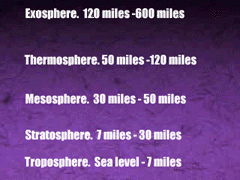These are a few terms used to describe the weather. Just a few ... to make your weather station more fun. These definitions are general and condensed. We don't recommend that you use them as answers to questions on your meteorology final. If you want to really get into it, the bookstores and libraries have thousands of books on weather, climate, the atmosphere, and other related topics.
Anemometer
The instrument that measures wind speed. In mechanical systems a rotating member, such as a propellor or a multiple cup device, spins at a rate proportional to the wind speed. In solid state systems, a thermal device cools at a rate proportional to wind speed.

Atmosphere
The blanket of gaseous chemicals surrounding the earth. It is broken into layers according to temperature. A given volume of pure, dry air contains about 78% nitrogen, 21% oxygen, and a 1% mixture of 9 other gases, including argon, carbon dioxide, neon, helium, krypton, hydrogen, xenon, ozone, and radon.
Barometric pressure
The pressure of the atmosphere.
Barometer
The instrument that measures the pressure of the atmosphere.
Cloud types
Clouds are divided into four families: high, middle, low, and clouds with vertical development. The first three types have two main sub-types: clouds formed vertically (cumulus), and clouds formed horizontally (stratus).
Cumulus. Starting from the highest altitude, clouds are named cirrocumulus, altocumulus, cumulus and stratocumulus. A cumulonimbus cloud starts low and can rise to 50,000 feet. This is a thunderhead or anvil cloud, and it is avoided by smart pilots like the plague.
Stratus. Again starting from the highest, we have cirrostratus, altostratus, nimbostratus and stratus (scud).
Another very high cloud is the cirrus, thin, featherlike clouds made of ice crystals. These are mares tail clouds.
Dew
Atmospheric moisture condensed to liquid on a surface. Cold dew is frost.
Dew Point
The temperature to which the air must be cooled at a constant pressure to become saturated. Pilots watch temperature/dew point spread for formation of fog.
Fog
Fog forms when the temperature is within 4 degrees F of the dew point. The air condenses and water vapor forms. Two basic varieties of fog are available: advection and convection.
Advection fog (toolie fog) usually forms close to the ground or water when warm air travels over a cool surface, or cool air travels over warm surface.
Convection fog forms higher in the air when rising warmer air meets cooler air.
Front
The boundry of two air masses. Generally considered warm fronts and cold fronts, but includes many others - occluded, upper, surface, and stationary to name a few.
A cold front is the leading edge of a cold air mass that is displacing warmer air in its path.
A warm front, conversely, is the leading edge of a warm air mass that is displacing a retreating colder air mass.